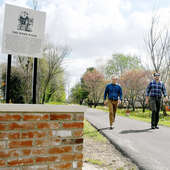The Information Superhighway: 20% of Missourians -- more than a million people -- without high-speed Internet

It's often referred to as the "Information Superhighway," and over the past few decades, the internet has become an indispensable part of our daily lives -- from information and communications to entertainment and online shopping.
Most people use the internet every day in one form or fashion, and in homes and businesses across the nation, it has become as common as electricity and indoor plumbing.
Yet in many parts of the country, including some regions of Missouri, the "Information Superhighway" is more of a "two-lane country road" because these areas lack high-speed broadband availability.
The Missouri Department of Economic Development says nearly 20% of Missourians -- more than a million people -- do not have access to high-speed internet, and the Federal Communications Commission ranks Missouri 41st in the nation in terms of broadband connectivity.
That's something Tim Arbeiter wants to change.
Arbeiter is director of broadband development with the Missouri Department of Economic Development. If his name sounds familiar, it's because he was executive director of Old Town Cape from 2004 to 2006 and then served 10 years as vice president for community development with the Cape Girardeau Area Chamber of Commerce. He left Cape Girardeau in 2016 to become the president of the Lee's Summit (Missouri) Chamber of Commerce and has been in his current position since June 2018.
"We have been feverishly working on efforts to help Missouri and the rural areas of the state that have scattered levels of service," Arbeiter says, adding that he expects Missouri to climb in the national broadband connectivity rankings over the next couple of years. "We have some ways to go."
The Missouri Department of Economic Development sees broadband availability as a "critical need" and has identified five core areas to help accelerate high speed accessibility, including:
* Increasing broadband data collection and utilization
* Accelerating broadband infrastructure and access
* Leveraging partnership to augment broadband expansion efforts
* Increasing broadband adoption and awareness
* Promoting efficiencies and opportunities in broadband development
According to Arbeiter, "Broadband has become a new form of infrastructure that is needed for economic, community and business success," and in the state's rural areas, he describes broadband expansion as a "gubernatorial priority."
Lack of broadband connectivity, he says, "slows down the nature of business. And that's not just a small business problem. This is a large business issue and an agricultural problem. When they don't have it, they have to figure out different ways to manage their businesses. It's an inhibitor when you don't have it."
In February, the Federal Communications Commission launched a 10-year, $20.4 billion Rural Digital Opportunity Fund to finance high-speed broadband networks in underserved rural regions of the nation, including parts of Southeast Missouri.
The United States Department of Agriculture also recently invested $103 million throughout Missouri to expand rural broadband coverage as part of the USDA ReConnect Program.
In addition to that funding, Arbeiter says the Department of Economic Development is in the final phases of its first broadband grant program, which will award several million dollars' worth of matching grants to companies and organizations to expand broadband coverage in some of the more rural portions of the state.
Most major communities in Southeast Missouri -- including Cape Girardeau, Jackson, Scott City, Perryville and Sikeston -- have at least one business and residential internet provider offering high-speed broadband connections, which Arbeiter defines as at least 25 Mbps (megabytes per second) download speed and at least 3 Mbps upload speed.
"That may not sound all that fast, but for some people, that's enough for them to do what they need to do on a daily basis," he says.
By contrast, "unserved" areas, Arbeiter explains, are those with internet connection speeds of less than 10 Mbps "down" and 1 Mbps "up," while "underserved" areas have connection speeds of between 10 and 25 Mbps "down" and between 1 and 3 Mbps "up."
As a rule of thumb, download speeds above 10 megabits per second are enough for streaming standard definition (SD) videos to devices via Wi-Fi connections, but speeds that low can be problematic when multiple users try to access high-bandwidth services such as video chats. Generally speaking, 25 Mbps are required for high-definition (HD) video streaming.
Most communities in Southeast Missouri have at least one internet provider service offering high-speed service, including some with download speeds approaching 1,000 Mbps.
According to the website broadbandnow.com, 85.6% of Missourians have access to wired broadband with speeds of 25 Mbps or faster, 81.7% have access to high-speed download connections of 100 Mbps or faster and 38.6% of the state's residents have access to connections with speeds of at least 1,000 Mbps.
In this area, 81.3% of Cape Girardeau County residents have access to broadband service, slightly less than the 84.3% of Scott County residents. In Perry County, the percentage is 50.4%, while in Bollinger County, only 0.8% of the county has broadband access, according to broadbandnow.com.
Where does Arbeiter see Missouri broadband connectivity in the next five years or so? "Oh gosh, by then, we'll be a lot further along than the 41st most-connected state," he says. "Hopefully by at least an interval of 10."































